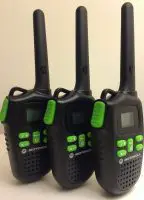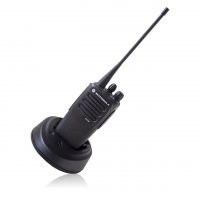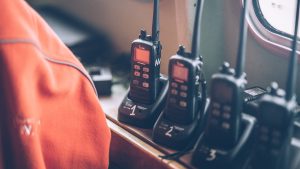By: Taylor Thomas
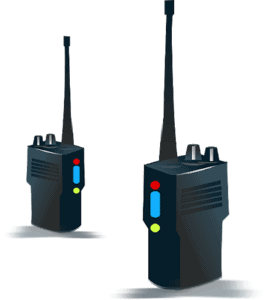
Walkie Talkies are primarily used to communicate information quickly from one radio to another. Walkie talkies allow people to talk to others in different areas by using the same radio channel. Law enforcement, firefighters, and public safety professionals all use handheld radios to converse between other officers and respond to an emergency instantaneously.
Walkie talkies have greatly advanced over the years but remain a constant form of communication with police and commercial radio users. Law enforcement frequently uses walkie talkies that are manufactured by Motorola, Harris, Kenwood, and BK Technologies. Police handhelds require more security and features that are needed to correctly do their job. They also are required to communicate back and forth with dispatch radios for critical information so having a more secure radio without interruption is essential. This makes police walkie talkies different than commercial walkie talkies.
Commercial walkie talkies are used throughout many industries like bar security, event staff at large venues, hikers, and used in businesses like warehouses or construction sites. These people require fast communication too but don’t necessarily need the advanced features and security as a police radio. These radios are simple to use and often allow businesses to communicate to requests from their team quickly compared to using cell phones that are not as efficient in reaching someone when needed. In cases of hiking, cell phones may not be available in dense parts of the mountains.
In this post, I’m going to review the key differences between a police walkie talkie vs commercial walkie talkie.
Within each walkie talkie we evaluated:
- Price
- Features
- FCC and Licensing Requirements
- Range
- Security
- Required Accessories
- Programming
Table of Contents
Price
Police walkie talkies require more security and durability than commercial walkie talkies. Therefore, the price is significantly higher than those of commercial handheld portable walkie talkies. On average, newer police radios go for around $800-$2000. Keep in mind this figure can be even higher depending on the options that are selected which can include but are not limited to AES encryption, P25 trunking, and various accessories choices. Commercial walkie talkies can be purchased for under $100 dependent on the features. The new BK Technologies KNG2 radio, that is popular with public safety professionals, goes for around $2000-$2500.
Police require additional accessories like speaker microphones and replacement batteries to fully communicate with other officers and get the most out of their radio. This adds to the overall cost of the handheld radios over time. Two-way radio accessories like ones from Waveband Communications are designed to enhance the capabilities of walkie talkies providing extra coverage with communication and durability of the radio.
Features
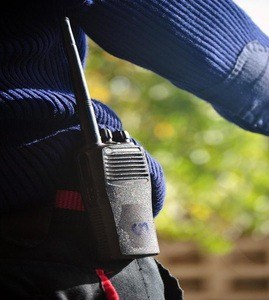 Commercial walkie talkies don’t have as many features or capabilities as police radios do. Police use radios that are specifically designed with public safety in mind. Many of the features of these radios are essential for law enforcement to effectively do their job.
Commercial walkie talkies don’t have as many features or capabilities as police radios do. Police use radios that are specifically designed with public safety in mind. Many of the features of these radios are essential for law enforcement to effectively do their job.
Police walkie talkies are P25 (Project 25). These radios have standards that are developed to provide digital voice and data communication systems designed for public safety officials. Police radios are also equipped with GPS, Bluetooth, LTE and WIFI capabilities. LTE in radios enables enhanced performance with data and limiting delay.
Police radios are more durable than a commercial walkie talkie. Radios can go through a test, enforced by the Department of Defense, to determine if the radio can withstand a range of environmental factors. Popular radios like Motorola APX 6000, Harris XL-200, and BK KNG2 and BKR 9000 are tested following MIL-STD 810 testing standards. It’s important for law enforcement to have radios that will work in various environments that they may be exposed to.
Commercial walkie talkies can vary in how many channels they offer. Some walkie talkies offer less than or more than 30 channels. Police walkie talkies have more channels, for example, the Harris XL-200 radios have 1,250 talk groups or 1000 channels.
The battery life in both a commercial walkie talkie and a police walkie talkie is around the same. Each battery will last you throughout the day before needing to be recharged again. Depending on how often you use the radio during the day, you will get about 10-15 hours of battery life. Police handhelds batteries can come in different Mah (milliamp hour) that measures power over time. The higher the Mah your battery has a longer battery capacity and life you will get out of it. If you’re not satisfied with your battery life swapping the battery out for a higher Mah can result in more hours of radio life during the day.
Commercial radios and police handhelds have SOS emergency features that can be used to alert others on your channel of an emergency. This is good to have if using a commercial radio for hiking in the case of injury and needing additional attention.
FCC and Licensing Requirements
Police handheld radios require an FCC license for operation. An FCC license is a license by the Federal Communications Commission that is required to operate radio equipment. Commercial walkie talkies do not require an FCC license to operate. This type of license is valid for 10 years and cost around $70 to obtain.
The FCC regulates the frequencies used by two-way radios. If your walkie talkie is labeled with FRS/GMRS or GMRS you are required to obtain an FCC license. An FRS (Family Radio Service) with a 462 & 467 MHz frequency is free to use without a license.
Two-way radios that are licensed are less likely to interfere with other communications.
Range
Commercial and Police walkie talkies have a different range. The distance you can go apart from the other radio user and still be able to communicate is dependent on conditions like the line of sight, wattage of radio, antennas and more. The range is limited in wooded areas or areas with lots of buildings because of obstruction. The signals coming from a walkie talkie aren’t good at penetrating through objects. Most likely, you’re not going to get the range that is advertised when you are purchasing the radio.
Commercial radios like FRS/GMRS are advertised to have up to 30-40-mile range. The higher the wattage of your radio is will give you a boost in range respectively. Police radios operate in a 700/800 MHz UHF band. This gives them a considerable amount of range which is pretty good in urban areas. The P25 radio systems give an improved range for officers.
Getting a larger antenna on your walkie talkie can improve the amount of range you receive. Antennas come in UHF, VHF and 700/800 Mah frequencies.
Security and Encryption
Law enforcement and other public safety officials are communicating information that is often classified and only for them to hear. For this reason, police radio systems are encrypted to secure communication and prevent eavesdroppers from listening in. Encryption encodes the audio signals in a way that hackers or anyone else trying to obtain information cannot understand it.
Walkie talkies used for commercial use often do not need encryption. The information transmitted and received doesn’t need to be secure and confidential. In the event information shall be secure, commercial walkie talkies can be encrypted.
Required Accessories
Police require two-way radio accessories to fully communicate with other officers. Radio accessories, like ones from Waveband Communications, enhance officer’s ability to communicate effectively. Motorola radio accessories include speaker microphones, surveillance earpieces, radio holsters, and batteries. Radio speaker microphones attach to the side of the radio. The speaker microphone allows for an easy access PTT without the need to pick up a radio and can sit comfortably on the officer’s shoulder. Police radio holsters can protect the radio from unnecessary damage that occurs from daily demands of policing. Surveillance earpieces can also attach to the radio to provide undercover units with the ability to communicate covertly.
Two-way radios require lithium batteries that can be interchangeable. It is typical to buy a new battery for your two-way radio every 12 to 18 months to get the most out of your radio. People using a commercial walkie talkie normally do not require additional accessories to communicate but manufacturers can have these accessories. Each accessory is only compatible with the certain type of radio you are using and the manufacturer.
Programming
Two-way radios can be programmed to expand the operating range. Programming allows for departments to have their specific customized channel. Some of the advantages of programming a two-way radio is
- Emergency call features
- Overcome dead spots when out on the field
- Better durability of the radio
- Connectivity during emergencies like natural disasters or power outages
Commercial radios are already preprogrammed before purchase due to the limited number of channels. Police programming requires a special programming software that is developed by the radio manufacturer. Programming radios require an intermediate level of expertise to develop the talk groups within the radio and involve a programming cable to do this. If you have multiple radios in your fleet, you can buy a cloning cable which allows you to expedite the programming process by duplication.
Wrap Up
Police walkie talkies are different than commercial walkie talkies by having improved security and durability. Police use their walkie talkies daily to communicate with other officers and dispatch to effectively do their job. These radios are manufactured with public safety professionals in mind. Walkie talkies provide people with the ability to communicate even if you are not right beside the person. Going through each walkie talkie’s features and what you require when communicating can help you decide which one is right for you.


